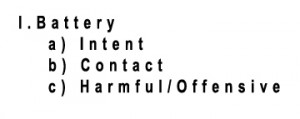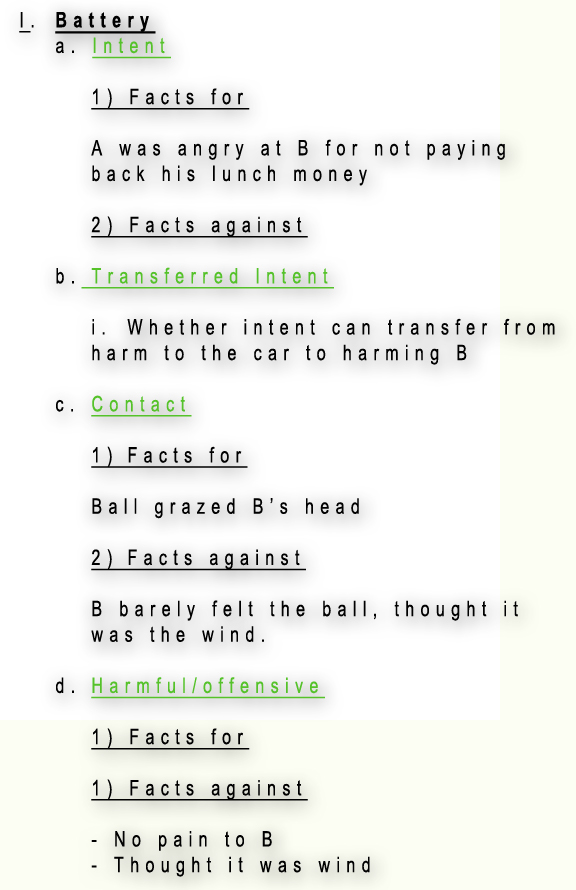Some of these may sound obvious and some not so much. Here is a list of the eight items to make sure you have in each of your bar exam essays. They are in order of importance, starting backward.
(8) Conclusion
Although, your conclusion should be obvious from your analysis, at the end of each issue, it’s always a good idea to put a quick, “Thus, it is likely A is liable for battery.” It really doesn’t matter whether you take the plaintiff’s or defendant’s side in your conclusion, so long as:
a) it is in alignment with your analysis, and
b) you write one down.
It may be worth only a couple points on the exam, so that’s why it makes this list, but not very high.
(7) Headings, (bold and/or underlined)
In our post on How they grade the bar exam essays, we stated that bar examiners take only three to five minutes per essay. If your exam is messy, they are not going to spend time re-reading confusing parts and trying to figure out what you wrote.
Thus, headings are SUPER-IMPORTANT! Look at every single model answer out there. Every single one of them have clear, concise, readable headings that tell the grader what issue he is going to read about.
Also, every good bar prep program will emphasize the use of headings. If a huge majority of people are using headings, don’t be the only one left out by not using them. If the grader reads groups of essays with headings then sees yours without it, it may alert him that this person doesn’t know how to keep things succinct and organized. So, tell the reader how professional you are by using headings.
More on headings here.
(6) Rule Statements
Are you shocked? You have probably been spending most of your time reading and memorizing rules and now, here I am, ranking rule statements as the 6th most important thing to have on an essay! Some people may disagree, but here me out.
Rule statements definitely ARE important. You could lower your answer score without including them; however, what is more important is not the rule, it’s how you applied the facts to the rule, as most of you know from law school!
I once saw a passing bar exam essay presented to us in my bar prep program that had only one rule statement in the entire exam! Yes, ONE RULE only. And it passed. Although, it did not contain rule statements as it should have, the exam did do a good job correctly analyzing the rules and using facts.
Here are some things to keep in mind:
a) You only need to know enough rules to establish ‘minimum competency,’
b) There will be times when you don’t know the rule and will need to make it up
Especially in California, the exam is designed to get under your skin for some of the essays. There will be times when you have no idea what a rule is and must play ‘judge’ and make one up.
Also, don’t ‘rule splurge.’ By that I mean don’t just spit out a giant list of all the rules in the beginning of the essay. State a rule only if you are about to use facts to show how the rule works.
Also, you don’t need to talk about policy or the history of a rule, unless you can show why that discussion is relevant to the pertinent case. And rarely will it be necessary to put on a bar exam.
The bottom line is the examiners know that you will look up the rules of law when you are an attorney. On the exam, they REALLY want to know if you can walk, write, and act the part of an attorney. That’s why I ranked rule statements so low. That being said, I’ll emphasize that they are important, but it’s five times better to spend time jumping into the essays and practicing the application of the rules, rather than memorizing the rules. By the end of my bar prep, I found doing essays was a better way to learn the rules than just reading outlines.
(5) Good, lawyerly writing
Despite all the studying, practicing, and rule memorizing you do, make sure you are WRITING like a lawyer. Be concise, direct, and flush out words that don’t need to be there. To be honest, my writing was not-so-hot going into bar exam prep. So, I spent time reviewing the barbri book essay answers to understand how they were structured. Sometimes, I would actually re-type their model essays word for word so I could truly get into the mindset of how it’s written. This helped a lot.
Most major bar prep programs won’t really focus on your writing ability and believe it or not, this is the black hole in bar prep programs. Students who are highly capable, and know the law, but have not developed their writing enough may have trouble with writing good answers. This was where I was and I passed, and you can too!
To develop good writing:
a) Focus on being concise and direct,
b) Constantly compare your exam answers with the good, passing answers for the essay you are writing,
c) Rewrite barbri and model answers to get a ‘feel’ and in the mindset of writing good, solid answers
This blog talks about how copying model answers was useful to helping him pass: http://www.jaywiseman.com/LAW_PassingTheBarExamEssay.html
(4) Organization
This goes hand-in-hand with headings. It’s very important for a writer to have organized writing and structure in the exam. The writing and layout of your exam should be clear, readable, and pleasant for the grader to read. The grader wants to feel satisfied after he’s done reading your exam, and you can make that happen by having new paragraphs between issues and sub-issues, clear headings, and short, concise writing.
The overall look and feel of the essay should be lawyerly. You won’t fail for having a couple wrong rules or missing a couple issues, but if you don’t know a rule or your rule statement is wrong, you can certainly make up lost ground by ‘looking’ the part of an attorney.
(3) Major Issues
Spotting your major issues on an exam is VERY important. There may be only one or two major issues that are worth most the points. There may be about three or four sub-issues. Missing some of these sub-issues is ok; however, make sure you hit the major issues. The major issues are usually very easy to spot. Just make sure you keep focused and find it because sometimes the issues can be very tricky or vague and you may have brain farts. Practice issue spotting on every practice essay you take and you’ll be A ok!
(2) Including all pertinent facts in application to rules
This is big! Every fact in the exam is there for a reason. Ask ‘why? why? why?’ did the graders use this fact? Why did they say ‘red corvette’ instead of ‘blue honda’? Why did they say, ‘he angrily waved his hands in the air,’ instead of ‘he kept his hands by his side.’ These little words are keys, hints, clues, and signals to you, the attorney, to talk about in your exam. They want you to pay attention to these details and use them in your fact analysis. Use them in the appropriate places also. Talk about the ‘speeding red corvette’ in analyzing whether the police had a lawful purpose in pulling the car over, not if you’re talking about the proper reading of Miranda rights (unless it is somehow relevant).
(1) Good analysis
No surprise here. It’s probably no surprise, but a good analysis, interweaving facts and law, is what will make your exam answer a passing one. If the trees are the law and people are the facts, a good analysis will be the people weaving through the forest, touching and talking about every tree that rests in their path. This does not mean you should talk about EVERY tree in the forest, only those in your path!
This is why it is essential to practice, practice, practice writing essays under timed conditions, and then review good answers for those essays. You practice walking the path and eventually there is no tree or path you are not familiar with or can’t handle.
As always, best of luck in preparing for and passing your bar exam!
“This name appears on the pass list”



 Rule #2 – Make sub headings either italicized or underlined
Rule #2 – Make sub headings either italicized or underlined 




